
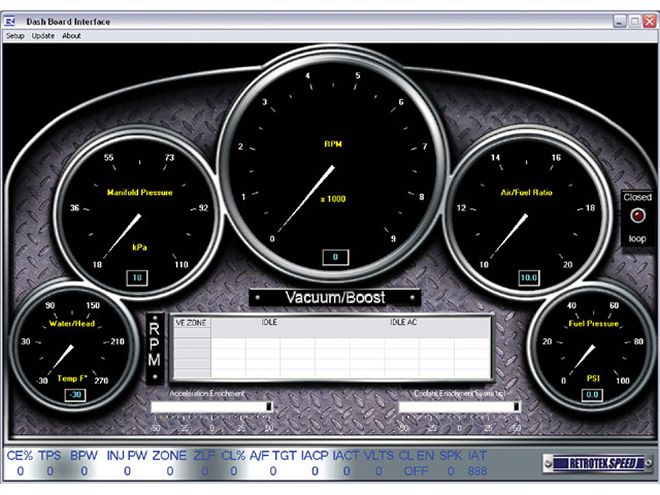
In a list of the top 10 reasons rodders shy away from EFI conversion, always hovering near the top is a phobia over the complexity of a fuel-injection system versus a carburetor, followed closely by dread over the amount of parts swapping required. After all, carbs are mechanical, familiar, and easy to tune. Also, you've probably already spent some time sorting out the details to dial in your carb'd combo perfectly. Why mess with perfection?
The rest of that list typically revolves around aesthetics. Maybe the efficiency, easy cranking, and 'round-town driveability of EFI sounds tempting, but when you pop the hood in answer to "What's it got in it?" the simplistic, traditional look of a carb is what you want admirers to see. Either way, a front-load-style intake or a throttle body with a set of fuel rails just doesn't jive. But you just can't have your cake and eat it too, right? Or can you? Let us introduce you to the best of both worlds.
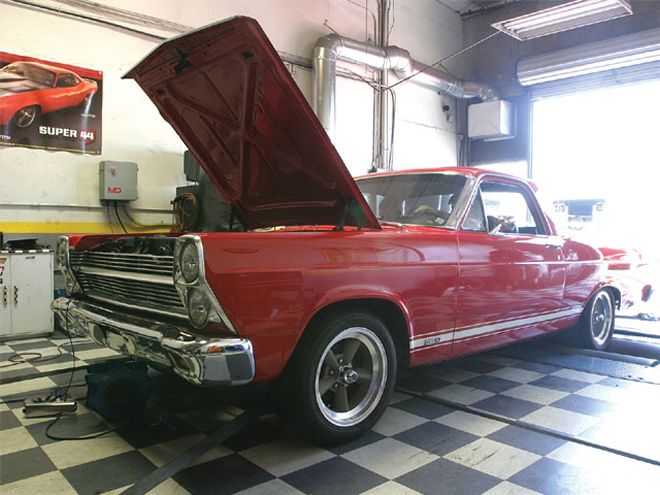
On the dyno at Wide Open Throttle (W.O.T.) in Riverside, California, Pete Andreas held us at a steady 65 mph at 0-, 5-, 7-, and 10-degree grades while Farrell adjusted the timing via the laptop. He managed to pick up around 5 lb-ft and 2 to 3 hp at each interval while lowering the fuel consumption by 2 to 5 percent. On a full run, we found another 6 hp and 10 lb-ft of peak torque. Even more importantly, there was a marked improvement in our overall acceleration curve. Not bad for an hour of tuning. Just for fun, we also ran a quarter-mile simulation and netted a 13.80 at 101 mph despite a fantastically lethargic 2-3 shift thanks to the green dot C-4 trans. To top it all off, we calculated an honest 17 mpg at a steady 65 mph on our mileage loop and saw roughly a 0.5-mpg improvement in city driving.
The Professional Products Powerjection system developed in conjunction with Retrotek Speed got the nod for our testing because it's a unique piece in the aftermarket. Yes, it's a throttle body, but it certainly doesn't look like one. It's aimed squarely at all those guys we just mentioned, the ones who want EFI but don't want to look like they have EFI. With the exact same dimensions as a Holley carb, the Powerjection fits any standard air cleaner assembly.
There's also good news for those dreading all the wiring and tuning; this is by far the simplest EFI system we've encountered, both in terms of installation and learning curve, no matter what you stick it on. There's no need to swap intakes, switch to a return-style fuel system, or even change any linkage. Really, we're not even talking about a weekend project here. Our carb-to-EFI swap took approximately five hours, lunch includ-ed. And as far as a learning curve, well, there really doesn't have to be one-the system can do it all for you.
Our '67 Ranchero test vehicle, recently out of long-term storage, was this writer's first car and somehow survived through high school and college. The 357ci Windsor is a basic recipe: 10.5:1 compression, Ford GT-40P iron heads, and a Crane hydraulic roller cam with 0.525/0.542 lift at the valve. Induction is a Ford Motorsport dual-plane intake, and exhaust flows through Hooker Super Comp headers into 21/2-inch pipes with Flowmaster 40-series mufflers. The trans is the original C-4 auto rebuilt with better guts and a mild shift kit but a stock converter. The third member is the original 8-inch peg leg with 3.00 cogs paired with 25.7-inch-tall 245/50R16 BFG rear tires on 16x8 Vintage Wheel Works V40s.
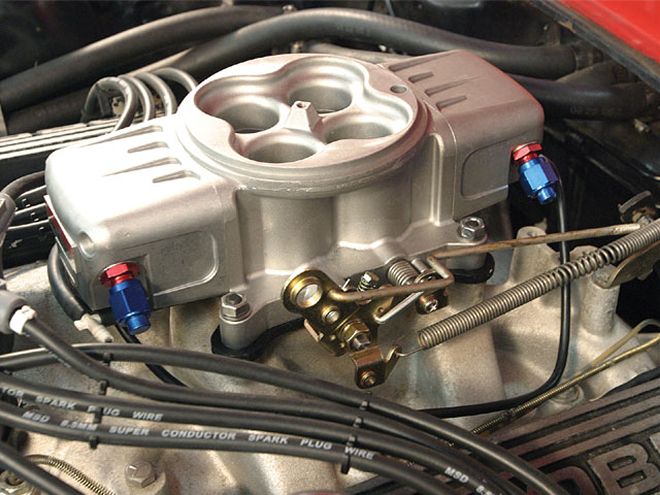 There's absolutely nothing interesting to show as far as the throttle body installation. If you can manage to turn four bolts and pop off your linkage, you're mostly there. Speaking of linkage, the Powerjection's matches up with the holes on a standard Holley, so there were no modifications to make here. Just clip your throttle cable back in exactly as it was.
There's absolutely nothing interesting to show as far as the throttle body installation. If you can manage to turn four bolts and pop off your linkage, you're mostly there. Speaking of linkage, the Powerjection's matches up with the holes on a standard Holley, so there were no modifications to make here. Just clip your throttle cable back in exactly as it was.
Running at a fairly steady 65 mph at 2,700 rpm, our fuel economy loop returned initial numbers of 13 mpg. During stop-and-go Los Angeles commuting, economy was a dismal 11 mpg-though it should be noted that the excessive idle time in L.A. traffic (1 hour to cover 12.5 miles) likely affected that number. After installation of the Powerjection, we covered the same loops in the as-learned state and saw 13 city and 15 highway. In a search for more, Retrotek Speed's Ken Farrell used the dashboard tuning software to change the cruising air/fuel ratio to a much leaner 14:1, which netted us another 1 mpg on the highway. And that's utilizing only the fuel control capabilities. When we swapped in a TFI distributor, we found more power and another mile per gallon, giving a total of 17 highway.
Intrigued? Follow along as we show you how easy it could be for you to have undercover EFI
MILEAGE TESTING INDUCTION CITY/HIGHWAY 650-cfm Holley Street HP 11/13 mpg Powerjection self-tune (fuel only) 13/15 mpg Powerjection manual tune (fuel only) 13/16 mpg Powerjection plus timing control 13.5/17 mpg DYNO TESTING INDUCTION HP LB-FT Carb 269 332 EFI 275 342Driving ImpressionsWhile overall peak horsepower and torque increases were modest, the torque increase on the low end was noticeable, particularly in quick starts from stoplight to stoplight. It helped overcome the disadvantage of the small 3.00 gears and get the Ranchero moving more quickly. The throttle also felt more responsive at cruising speed due to the increase in torque, especially at less than 3,000 rpm. It took a little time to remember to let the fuel pump prime first and resist pumping the pedal, but starting was always quick and consistent regardless of temperature or how long the truck sat idle. Once the idle settles down from the initial warm-up, revs come in at a steady 750.
A gain of 4 mpg is nothing to sneeze at, but of course, unless you drive the car a lot, the difference at the pump will take a while to really add up. It sure feels nice to get those extra miles per tank, though. For comparison, 10,000 miles per year (solely freeway driving) at the current average of $4.50 would cost roughly $3,462, while just L.A.-style commuting would be in the range of $4,091. With the mileage increase, savings over the same 10,000 miles are $815.00 highway and $758.00 city.
How do they know it will work?Because they've tested every single one of them. Before the kits are even boxed, every Powerjection system is placed on a stock 350 Chevy to set the idle and to ensure all components function as they should. If you have an issue, Farrell and his crew are just a phone call away to walk you through the troubleshooting process.
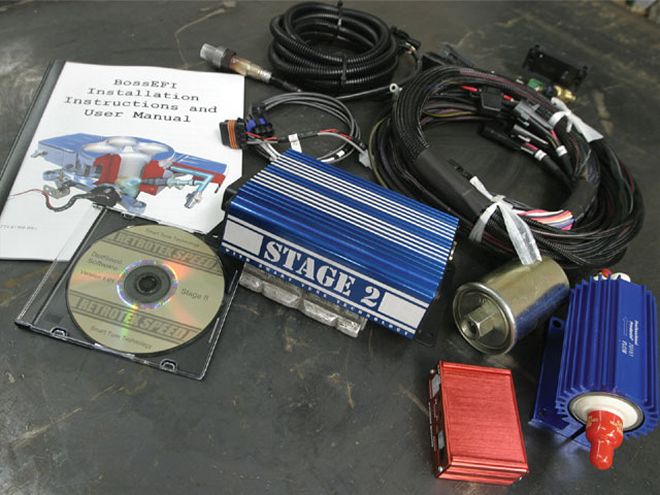
The kit we'll be working with is the Powerjection Stage 2 EMS. The batch fire-style Smart-Tune software uses adaptive learning coupled with a wide-band 02 sensor to dial in everything from stock TBI to blown multiport EFI simply by adjusting the air/fuel ratios nearly instantly to the preset safe levels or your input. It's also compatible with all ignition systems-factory or aftermarket, electronic or points-and can operate coil-on-plug engines when paired with an aftermarket ignition control. All sensors are standard GM/Ford style, so they can be found at any major parts house, including the provided one bar MAP sensor (two and three bar sensors are available for boost up to 30 psi).
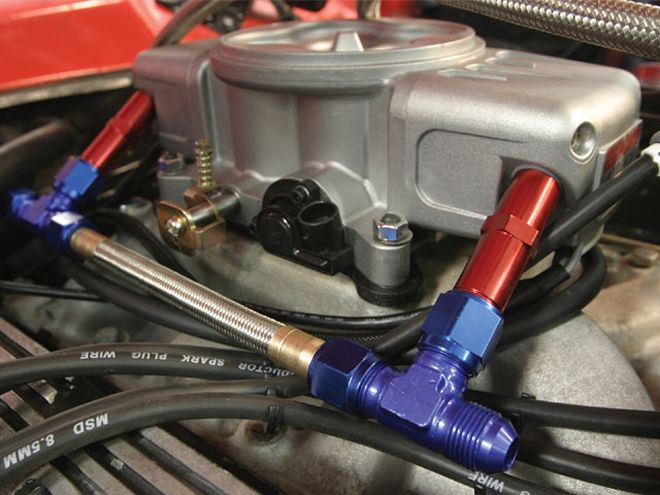
The dual-feed inlet is also a standard length, so you've got options should the braided line not suit your taste. Our MAP sensor is hidden on the firewall behind the engine using a factory bolt. It only requires a small length of vacuum line attached to a port at the rear of the throttle body. The small black plug is the throttle position sensor, which will be wired to the EMS. Hopefully, you have a vacant coolant bung, as the EMS needs a temperature sensor reading as well.
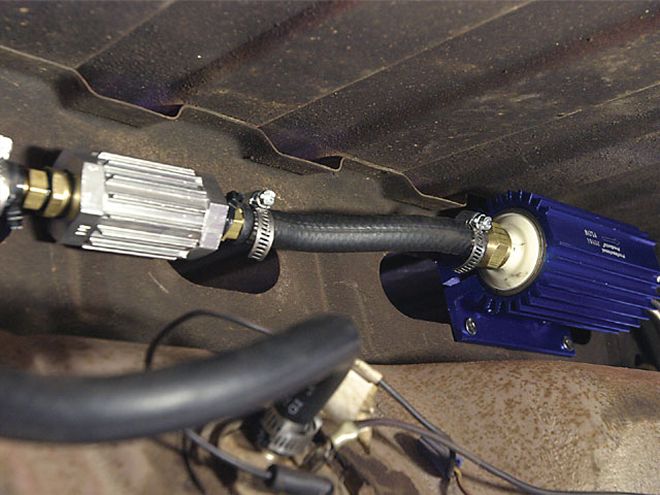
Here's the secret to the minimal fuel system modifications. The pulse width modulation (PWM) fuel system regulates the pressure by switching on and off as necessary to maintain roughly 40 psi. As such, wires for both power and correspondence with the EMS need to be plumbed to the pump. Typically, the pump and prefilter (left) must be mounted below the fuel pickup.

It's not necessary to get the vehicle running, but to view what's going on with the engine or make changes, the Smart-Tune software must be loaded onto a laptop PC. The software is user-friendly for the unfamiliar but also doesn't impede the experienced. The Smart-Tune will let you go as deep into the programming as you'd like for tuning purposes-provided you accept the related warnings along the way.
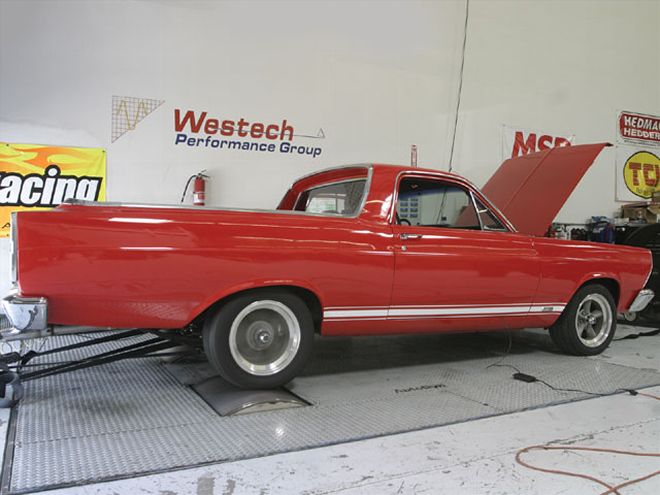
Back on the chassis dyno at Westech, the Powerjection was initially down across the board. Farrell said, "You obviously haven't been driving it very hard. Run it again." On the second pull with no adjustments, the Powerjection curve laid perfectly over the previously dyno-tuned 650 Holley, repeating the original 269 hp and 332 lb-ft of torque peak carb numbers. Below 3,000 rpm, however, the Powerjection produced more torque.
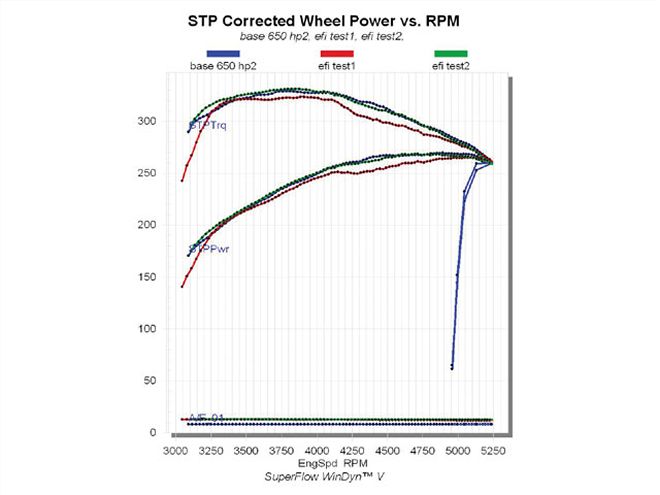
Man, we really need some heads on this thing. The excessively early power peak followed by a long plateau shows our small-valved GT-40P heads just can't flow enough air for the cam. Still, it's not too bad for a $2,000 carb-to-pan 351W. "You don't need a dyno. I usually find a nice, big, empty parking lot and just light 'em up to tune it," Farrell tells us. That's coming from one of the guys who designed the system, by the way.